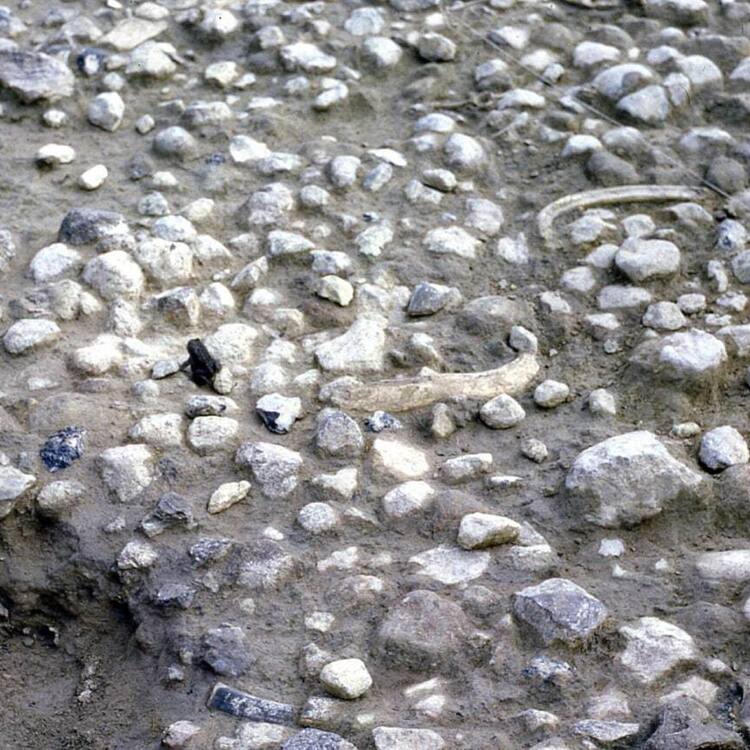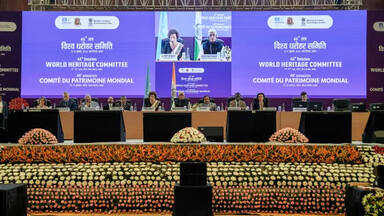Melka Kunture and Balchit: Archaeological and Palaeontological Sites in the Highland Area of Ethiopia
Melka Kunture and Balchit: Archaeological and Palaeontological Sites in the Highland Area of Ethiopia
Located in the Upper Awash Valley in Ethiopia, the serial property is a cluster of prehistoric sites that preserve archaeological and palaeontological records – including footprints – that testify to the area’s occupation by the hominin groups from two million years ago. The sites, situated about 2,000 to 2,200 metres above sea level, yielded Homo erectus, Homo heidelbergensis and archaic Homo sapiens fossils, documented in well-dated strata in association with various tools made from volcanic rocks. The cultural sequence includes four consecutive phases of the Oldowan, Acheulean, Middle Stone Age and Late Stone Age techno-complexes. Fragments of palaeo-landscapes, preserved buried under volcanic and sedimentary deposits with fossil fauna and flora, allow reconstruction of the high-mountain ecosystem of the Ethiopian Highlands during the Pleistocene. Conclusions can thus be drawn on the adaptation of hominin groups to the challenges and climatic conditions of high altitudes.
Description is available under license CC-BY-SA IGO 3.0
Melka Kontouré et Balchit : sites archéologiques et paléontologiques de la région des hauts plateaux d’Éthiopie
Situé dans la haute vallée de l’Aouache, en Éthiopie, le bien en série est un ensemble de sites préhistoriques renfermant des vestiges paléontologiques et archéologiques – notamment des empreintes de pieds – qui témoignent de l’occupation de la région par des groupes d’homininés il y a deux millions d’années. Ces sites, à une altitude d’environ 2 000 à 2 200 mètres au-dessus du niveau de la mer, ont révélé des restes fossilisés d’Homo erectus, Homo heidelbergensis et Homo sapiens archaïque documentés dans des strates bien datées aux côtés de divers outils lithiques façonnés à partir de roches volcaniques. La séquence culturelle représente quatre phases consécutives, à savoir les techno-complexes de l’Oldowayen, de l’Acheuléen, du Paléolithique moyen et du Paléolithique supérieur. Des fragments de paléopaysages, ensevelis sous les tufs volcaniques et les dépôts sédimentaires et des vestiges fossiles d’animaux et de végétaux permettent de reconstituer l’écosystème de haute montagne des hauts plateaux éthiopiens du Pléistocène. On peut donc en tirer des conclusions sur l’adaptation des groupes d’homininés aux difficultés et aux conditions climatiques des hautes altitudes.
Description is available under license CC-BY-SA IGO 3.0
موقع ميلكا كونتور وبالشيت: المواقع الأثرية والأحفورية في منطقة المرتفعات الإثيوبية
يوجد هذا الموقع المتسلسل في وادي الأواش الأعلى بإثيوبيا، وهو عبارة عن مجموعة من مواقع ما قبل التاريخ التي تحافظ على سجلات أثرية وأحفورية قديمة - بما في ذلك آثار الأقدام. وتشهد هذه السجلات على استيطان قبائل البشراناوات (أشباه البشر) في الموقع منذ مليوني عام. يوجد في هذه المواقع التي يتراوح ارتفاعها عن مستوى سطح البحر من 2000 إلى 2200 متر، أحافير للإنسان المنتصب القامة والإنسان هايدلبيرغ والإنسان البدائي العاقل، وهذه الأحافير مؤرخة جيداً في طبقات تضم أيضاً أدوات مختلفة مصنوعة من الصخور البركانية. ويضم التسلسل الثقافي أربع مراحل متعاقبة تتجسد في المجامع التقنية التي تعود إلى النمط الأول للصناعة الحجرية (المرحلة الأولدوانية) والنمط الثاني للصناعة الحجرية (الأشولينية) والعصر الحجري المتوسط والعصر الحجري الحديث. أتاحت أجزاء المناظر الطبيعية القديمة المحفوظة تحت الرواسب البركانية والصخور الرسوبية مع بقايا حيوانات ونباتات متحجرة، إعادة بناء النظام البيئي الجبلي للمرتفعات الإثيوبية خلال العصر البلستوسيني (العصر الحديث الأقرب). يمكن بالتالي التوصل إلى أنّ قبائل البشراناوات كانت تتكيف مع التحديات والظروف المناخية للارتفاعات الشاهقة.
source: UNESCO/CPE
Description is available under license CC-BY-SA IGO 3.0
梅尔卡·昆图尔和巴尔奇特考古与古生物遗址
梅尔卡·昆图尔(Melka Kunture)和巴尔奇特(Balchit)考古与古生物遗址系列遗产是位于阿瓦什河上游河谷的史前遗址群,保存着丰富的考古遗迹与包括脚印在内的古生物记录,展现了200万年前人族在该地区的生活痕迹。遗址位于海拔约2000-2200米处,年代久远的地层出土了直立人、海德堡人、古智人化石,以及以火山岩制成的各种工具。遗存的文化序列包括4个连续阶段的技术复合体:奥杜韦文化、阿舍利文化、中石器时代、石器时代。埋藏在火山岩和沉积岩下的古地貌碎片及动植物化石,为重建更新世时代埃塞俄比亚高原的高山生态系统创造了条件,从而揭示远古人族如何适应高海拔地区的挑战与气候条件。
source: UNESCO/CPE
Description is available under license CC-BY-SA IGO 3.0
Археологические и палеонтологические объекты Мелка-Контуре и Балхит в высокогорном районе Эфиопии
Этот серийный объект расположен в верхней части долины реки Аваш в Эфиопии. Он включает в себя группу доисторических стоянок, на территории которых были обнаружены археологические и палеонтологические объекты, в том числе отпечатки ног, свидетельствующие о том, что гоминины заселяли эту территорию два миллиона лет назад. В этих местах, расположенных на высоте от 2 000 до 2 200 метров над уровнем моря, обнаружены окаменелости человека прямоходящего (Homo erectus), гейдельбергского человека (Homo heidelbergensis) и останков архаичного человека разумного (Homo sapiens). Эти окаменелости найдены в хорошо сохранившихся пластах вместе с различными орудиями труда, изготовленными из вулканических пород. Смена культурных эпох включает четыре последовательные фазы технокомплексов олдувайского, ашельского, среднего каменного и позднего каменного веков. Фрагменты палеоландшафтов, сохранившиеся под вулканическими и осадочными отложениями с ископаемой фауной и флорой, позволяют реконструировать высокогорную экосистему Эфиопского нагорья в эпоху плейстоцена. Таким образом, можно сделать выводы об адаптации гомининов к трудным условиям и климату высокогорья.
source: UNESCO/CPE
Description is available under license CC-BY-SA IGO 3.0
Melka Kunture y Balchit: Yacimientos arqueológicos y paleontológicos del Macizo etíope
Este sitio en serie, situado en el Valle Alto del Awash, en Etiopía, es un conjunto de yacimientos prehistóricos que conservan registros arqueológicos y paleontológicos –entre los cuales huellas– que atestiguan que la zona ha sido ocupada por grupos de homínidos desde hace dos millones de años. Los yacimientos, que se encuentran entre 2000 y 2200 metros sobre el nivel del mar, han proporcionado fósiles de Homo erectus, Homo hedelbergensis y Homo sapiens arcaico, documentados en estratos bien datados junto con diversas herramientas fabricadas con rocas volcánicas. La secuencia cultural comprende cuatro fases consecutivas de los tecnocomplejos Olduvayense, Achelense, de la Edad de Piedra Media y de la Edad de Piedra Tardía. Los fragmentos de paleopaisajes, que se han conservado enterrados bajo depósitos volcánicos y sedimentarios con fauna y flora fósiles, permiten reconstruir el ecosistema de alta montaña de las Tierras Altas de Etiopía durante el Pleistoceno. De este modo, pueden extraerse conclusiones sobre la adaptación de los grupos de homínidos a los desafíos y las condiciones climáticas en zonas de gran altitud.
source: UNESCO/CPE
Description is available under license CC-BY-SA IGO 3.0
Outstanding Universal Value
Brief synthesis
The cluster of Pleistocene archaeological and palaeontological sites of Melka Kunture and Balchit lies along the upper course of the Awash River, on the Ethiopian Highlands, at an altitude of about 2,000 to 2,200 metres above the sea level. With a relatively continuous stratigraphic sequence formed by the accumulation of fluvial/alluvial and volcano-derived deposits interposed with tuff, the property preserves an exceptionally long cultural sequence consisting of four consecutive phases of the Oldowan, Acheulean, Middle Stone Age and Late Stone Age techno-complexes, documented in a variety of archaeological contexts, testifying to the occupation of the area by hominin groups from two million years ago. Fragments of palaeo-landscapes preserved buried under the volcanic and sedimentary deposits with fossil fauna and flora allow to reconstruct the high-mountain ecosystem of the Ethiopian Highlands during the Pleistocene and draw conclusions on the adaptation of hominins to the challenges and climatic conditions of high altitudes. The presence of Homo erectus, Homo heidelbergensis and archaic Homo sapiens fossils, found in association with well-dated archaeological material, throws light on the development of skills and cognitive capacities in the early hominin groups. Rich concentration of varied lithic assemblages made from volcanic rocks with different knapping techniques, and evidence of high-quality of standardised obsidian tools, suggest a level of planning and innovation. Evidence of the centuries-long tradition of procurement and use of obsidian starting with the Oldowan industry makes the property the earliest known example of obsidian utilisation and an outstanding witness of continuity of exploitation of this raw material.
The component parts together contribute to the understanding of human evolution, allowing to revisit the existing theories related to the transitions between the techno-industries, and suggesting fundamental steps in the development of human intelligence and adaptation skills. They also provide valuable information on the sedimentary history of the area and allow to determine the chronology of cultural horizons of the Pleistocene epoch based on the dating of volcanic tuffs preserved in the Melka Kunture succession.
Criterion (iii): The ensemble of Pleistocene archaeological and palaeontological sites of Melka Kunture and Balchit is the only known place in the world to have preserved in a single area an exceptionally long cultural sequence consisting of four consecutive phases of Oldowan, Acheulean, Middle Stone Age and Late Stone Age techno-complexes. Hominin fossils of Homo erectus, Homo heidelbergensis and archaic Homo sapiens discovered in well-dated archaeological layers with Oldowan, Acheulean and Middle Stone Age industries, paired with the evidence of varying use of different rocks through time, contribute to the understanding of human evolution, development of cognitive capacities in early hominin groups, and their adaptation to the environment by employing different strategies of raw material procurement and use.
Criterion (iv): Fragments of Quaternary fossil landscapes, preserved buried under volcanic tuffs and sedimentary deposits of the ensemble of Pleistocene archaeological and palaeontological sites of Melka Kunture and Balchit, allow to reconstruct the palaeo-environment and palaeo-climate of the Ethiopian Highlands during the Pleistocene epoch and understand better the lifestyle of hominin groups occupying the area. Hominin remains documented within the property provide one of the earliest evidence of human occupation of high altitudes and their adaptation to the high-mountain ecosystem, different from the dry savannas of lower elevations, which marks a significant stage in human history. The volcanic material that buried the palaeo-landscapes has scientific value as it allows to date and establish the chronology of the cultural horizons.
Criterion (v): The cluster of Pleistocene archaeological and palaeontological sites of Melka Kunture and Balchit testifies in an exceptional way to the consistent exploitation of obsidian as a raw material and its extensive use for tool production that starts with the Oldowan industry. It is the earliest known example of obsidian utilisation, and the only known place in the world that holds an uninterrupted record of systematic procurement of this volcanic glass and its knapping since two million years ago. High-quality and quantity of standardised obsidian tools found in Acheulean contexts suggests possible introduction of specialised production sites.
Integrity
All component parts contribute substantially to the Outstanding Universal Value, providing complementary evidence on the evolution and activity of hominin groups, their natural environment and the sedimentary history of the Upper Awash River basin over the span of two million years. The archaeological and palaeontological deposits and the deep stratigraphy are well-preserved throughout the property. The excavated sections have been backfilled, except for one section which has been left open for public display. Artefacts and hominin remains are stored and exhibited in the Ethiopian National Museum in Addis Ababa and the site museum. The component parts suffer from erosion to a small extent, due mainly to seasonal overflows of the Awash River. Intactness of the deposits in some areas is threatened by activities related to sand quarrying. The setting of the property has been largely preserved and the areas with future research potential have been included within the buffer zones to protect them from potential encroachment related to development of the area or agricultural practices.
Authenticity
The area has been excavated to a small degree and the context of the sites remains intact. The cultural sequence and the geologic record – with volcanic tuffs that allow to determine the chronology of cultural horizons – are preserved undisturbed. The immediate setting of the property has not been compromised but the expansion of settlements and the related development of infrastructure need to be monitored at some of the component parts.
Protection and management requirements
The property is a registered national heritage, owned by the state while people receive usufruct rights to plots of land. All component parts and the buffer zones are protected through the Regulation No. 159/2013. At the highest level, the property is managed by the Oromia Culture and Tourism Bureau, in collaboration with the Authority for Research and Conservation of Cultural Heritage (ARCCH). At the site level, the Administration and Preservation Office is responsible for the day-to-day administration of the property and coordination of stakeholder relations. Since the property falls under two different Woredas and Administrative Zones, the respective Culture and Tourism offices of the Oromia Culture and Tourism Bureau serve as a bridge between the site administration and other government institutions at higher levels, at the district and administrative zone levels.
The management plan (2022-2027) has been developed through a consultative process and will be implemented collaboratively by the Oromia Culture and Tourism Bureau, and ARCCH. Local communities will be actively engaged in the management and development of the property to ensure conflict-free protection of the archaeological and palaeontological sites. Key challenges in the short term will be to put in place adequate procedures and practical mechanisms to guarantee effective protection and management of the property within the existing legal framework, to strengthen human capacity, and to ensure sustainability of funds for the maintenance of the property.


